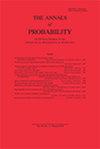随机微分方程的光滑逼近
IF 2.5
1区 数学
Q1 STATISTICS & PROBABILITY
引用次数: 90
摘要
考虑一个Ito过程X满足随机微分方程dX=a(X)dt+b(X)dW,其中a,b是光滑的,W是多维布朗运动。假设Wn具有光滑的样本路径,并且Wn弱收敛于w。随机分析中的一个中心问题是理解常微分方程dXn= A (Xn)dt+b(Xn)dWn的解Xn的极限行为。经典的Wong-Zakai定理给出了Xn弱收敛于X的充分条件,在此条件下,随机积分∫b(X)dW给出了Stratonovich解释。在一维中充分条件是自动的,但在高维中∫b(X)dW的正确解释敏感地取决于Wnis如何选择光滑近似。在应用中,通过设置Wn(t)=n−1/2∫nt0v°ϕsds,产生了一类自然的光滑近似,其中,ϕt是一个流(例如由常微分方程产生),v是一个可观测的平均零。在温和条件下,我们给出了随机积分∫b(X)dW的解释问题的确定答案。我们的理论适用于阿诺索夫流或公理A流,以及一大类非均匀双曲流(包括由著名的洛伦兹方程定义的流),我们的主要结果不需要任何混合假设。本文采用的方法是粗糙路径理论与光滑遍历理论的结合。本文章由计算机程序翻译,如有差异,请以英文原文为准。
Smooth approximation of stochastic differential equations
Consider an Ito process X satisfying the stochastic differential equation dX=a(X)dt+b(X)dW where a,b are smooth and W is a multidimensional Brownian motion. Suppose that Wn has smooth sample paths and that Wn converges weakly to W. A central question in stochastic analysis is to understand the limiting behavior of solutions Xn to the ordinary differential equation dXn=a(Xn)dt+b(Xn)dWn.
The classical Wong–Zakai theorem gives sufficient conditions under which Xn
converges weakly to X provided that the stochastic integral ∫b(X)dW is given the Stratonovich interpretation. The sufficient conditions are automatic in one dimension, but in higher dimensions the correct interpretation of ∫b(X)dW depends sensitively on how the smooth approximation Wnis chosen.
In applications, a natural class of smooth approximations arise by setting Wn(t)=n−1/2∫nt0v∘ϕsds where ϕt is a flow (generated, e.g., by an ordinary differential equation) and v is a mean zero observable. Under mild conditions on ϕt, we give a definitive answer to the interpretation question for the stochastic integral ∫b(X)dW. Our theory applies to Anosov or Axiom A flows ϕt, as well as to a large class of nonuniformly hyperbolic flows (including the one defined by the well-known Lorenz equations) and our main results do not require any mixing assumptions on ϕt.
The methods used in this paper are a combination of rough path theory and smooth ergodic theory.
求助全文
通过发布文献求助,成功后即可免费获取论文全文。
去求助
来源期刊

Annals of Probability
数学-统计学与概率论
CiteScore
4.60
自引率
8.70%
发文量
61
审稿时长
6-12 weeks
期刊介绍:
The Annals of Probability publishes research papers in modern probability theory, its relations to other areas of mathematics, and its applications in the physical and biological sciences. Emphasis is on importance, interest, and originality – formal novelty and correctness are not sufficient for publication. The Annals will also publish authoritative review papers and surveys of areas in vigorous development.
 求助内容:
求助内容: 应助结果提醒方式:
应助结果提醒方式:


